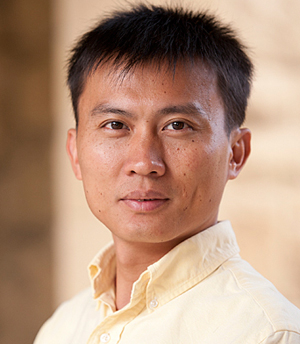Subscribe
Subscribe Now to receive Goldsea updates!
- Subscribe for updates on Goldsea: Asian American Supersite


Battery researcher Yi Cui has developed an economical, high-capacity electrode that can maintain most of its capacity over 40,000 charge cycles. These characteristics make it ideal for use in batteries to stabilize supply and demand on electric power grids.
“For grid storage, the battery can be huge, and using sodium and potassium is very attractive because they are so abundant and cheap,” Cui says.
Like lithium-ion batteries, Cui’s relies on the flow of sodium and potassium ions between electrodes during charging and discharging. To save even more, his batteries will use water-based electrolytes that are cheaper and easier to use than organic solvent-based electrolytes used in lithium-ion batteries.
Cui’s Stanford University research team used the pigment Prussian Blue, a compound of iron and cyanide but replaced half the iron with copper — all of which are commonly available, relatively inexpensive materials. That mix was turned into crystalline nanoparticles with which to coat a cloth-like carbon substrate. This electrode was immersed into a potassium nitrate electrolyte solution. A paper detailing the team’s procedures was posted online in the journal Nature Communications.
The resulting electrodes achieved 99% energy efficiency.
“You want the voltage you put in during charging and the voltage you take out during discharge to be same,” says Cui. “Compared to any other battery material, this is absolutely the best.”
Most importantly for batteries that will be used in electric power grids, Cui’s electrodes retain 83% of their charge capacity after 40,000 cycles. Lead-acid batteries commonly used for electric grids last a few hundred cycles. Expensive lithium-ion batteries — whose main virtue is their weight to-power ratio — unimportant in grid use — last about 1,000 cycles.
So far Cui’s team has used the new electrode as a cathode, but is at work adjusting the chemistry for use as an anode as the next step toward building prototype batteries.
In March 2011 Cui’s battery startup Amprius, founded in 2008, raised $25 million to commercialize his breakthrough in using silicon nano-wires to boost the efficiency of lithium-ion batteries.
Cui is something of a superstar researcher, as well as an associate professor, at Stanford. His breakthroughs in devising ways to configure functioning devices on the nano scale attracted a $10 million grant from Saudi Arabia’s King Abdullah University of Science and Technology (KAUST). That grant is currently funding Cui’s sizeable Stanford research group focused on nanoscale phenomena for energy conversion, electronics, and nanobiotechnolog. His group has developed nanowire and nanocrystal materials for energy storage, solar cell and memory devices.
Cui was the first person to demonstrate nanowire field effect biosensors. He has published 32 research papers related to nanowires and nanocrystals. He has presented his work in over 70 invited talks at conferences, universities, and research centers around the world. Among his inventions is a process for turning clothing into a battery by dying fabric with a solutioin containing carbon nanotubes.
Yi Cui graduated from China’s University of Science and Technology in 1998. He moved to the U.S. to study at Harvard and obtained his PhD in chemistry there in 2002. He completed a two-year postdoctoral research project on electronics and colloidal nanocrystals at the University of California, Berkeley from 2003 to 2005. He then joined the Stanford University faculty as an assistant professor in the department of materials science and engineering. In 2010 he was elevated to the status of an associate professor. In 2011 was was appointed to the Photon Science Faculty at the SLAC National Accelerator Laboratory.

Yi Cui is a Stanford materials science professor who is a foremost researcher in the fields of efficient batteries and the use of nano materials.